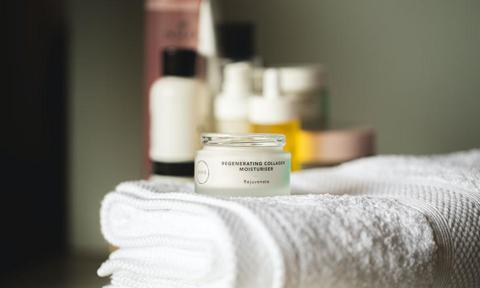
Through the pages of history, the beauty industry has been known for its resilience, bouncing back from devastating global crises with tenacity. When World War II placed discretionary spending on hold, lipsticks emerged as the new marker of indulgence, spawning the term ‘The Lipstick Effect’. When the world found itself confronted with an unprecedented pandemic, beauty again rose to the occasion with skincare replacing lipsticks in the spotlight—serving as a handy reminder not just to take care of our skin, but ourselves as well.
Future Of The Indian Beauty Industry
Here, we speak to experts about how skincare has been assuming precedence in the post-pandemic era.
Skincare: How The Industry Has Been Trumping Makeup

At a time when we had nowhere to go beyond our living rooms, it comes as little surprise that statement red lipsticks were swapped in favour of a rejuvenating sheet mask instead. For Madhavi Irani, director of customer engagement at Enrich Beauty, the pandemic afforded time to reflect inwards and re-evaluate our relationship with beauty. “The time to look inwards brought about an increased focus on holistic beauty. Without the need to dress up and head out the door every morning, we’ve focused on taking care of ourselves inside out—from eating more veggies and fruits to taking our vitamins and taking better care of our skin and hair,” she says.
The proof is in the numbers—while makeup staples took a backseat during the pandemic, the skincare industry has been surging forth. According to reports, skincare takes the biggest share of lunch by assuming 42% of the global beauty market, followed by haircare at 22% and makeup trailing behind at 16% in the year 2020. With a projected revenue of $177 billion by the year 2025, the Asia-Pacific region has been dominating sales charts by taking up 43% of the market share within skincare.
So, what is inspiring people to adopt skincare in their lives at an accelerated pace? Irani muses, “With the widespread quarantines and fear of stepping out to get routine grooming services, most people have altered their spending habits and gravitated towards products that allow them to mimic the in-salon experience at home. This is why skincare and haircare sales have trumped make-up, a category that most people haven’t touched over the last two years.”
The Skinification Of Beauty

With limitless time on our hands, skincare savviness has been touching newer heights as people began employing their time towards educating themselves. Ingredient searches witnessed a stratospheric rise on Google, with search queries like, “what does vitamin C do for your skin?” clocking in a 204 percent increase in 2020 as compared to the past year. The result? A larger shift towards formulas that solve skin concerns to negate the need for heavy make-up to conceal them.
Irani agrees, and adds, “People are now relying more on skin formulas to give them that natural glow, rather than highlighters. As we move forward, there will be a renewed focus on skin actives and hero ingredients as customers have become more discerning about what they apply to their faces. Skincare heroes like retinol, hyaluronic acid, niacinamide, vitamin C, ceramides, peptides, BHAs and AHAs in serums, essences, day and night creams and sunscreens will rule the day.” The corresponding increase in at-home skin treatments and skin tools will trigger a spike in the demand for face masks and overnight rejuvenating treatments, she predicts.
Smita Baisakhia, cosmetologist and head of product development at MyGlamm, agrees. “Consumers are now extremely particular about what they apply on their faces and are looking at the ingredients in products they use. They are looking for quick, simplified routines that have long-lasting results while being multi-functional. They aren’t driven solely by trends anymore as they understand the importance of listening to one’s skin,” she explains.
Skincare Vs Makeup: The Future Of The Beauty Industry In The Post-Pandemic Era

As the world limps back to a semblance of normalcy, it would appear that skincare’s reign over the beauty industry won’t go undisputed for long. With double vaccinations and booster shots offering hope for the future, different categories of make-up have been fighting back—“Eye make-up will continue to see an uptake, while ‘make-up minimalism’ will remain popular. This translates into a heavier reliance on lip stains, all-in-one base products as well as basic eye and brow formulas. As newer variants lose potency, there might also be renewed interest in ‘revenge make-up’ with bolder, glossier lipstick formulas, embellished eye make-up products and metallic formulas seeing a resurgence,” explains Irani.
For Baisakhia, consumer conversations have served as a clear indicator of how the beauty landscape has changed. “We noticed that despite the ubiquity of masks, purchases of lipsticks weren’t affected but the focus shifted on the types of formulas that are in demand as consumers are now looking for long-lasting and non-transferable lipsticks,” she says.
The two opposing forces of skincare and make-up could also come together for a harmonious union, with skincare-infused make-up finding popularity—think serum-based foundations and non-drying lip colours infused with argan oil. “Skincare enthusiasts have been demanding multi-functional make-up that nourishes and protects the skin for a while now, and the focus will be on products that make you look and feel great. Thanks to the new customer mindset of looking for holistic beauty options and using single products with multiple benefits rather than layering on formulas, skincare-infused make-up will pave the way for the future,” Irani concludes.






